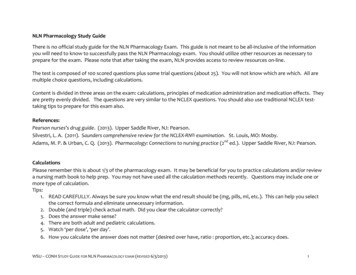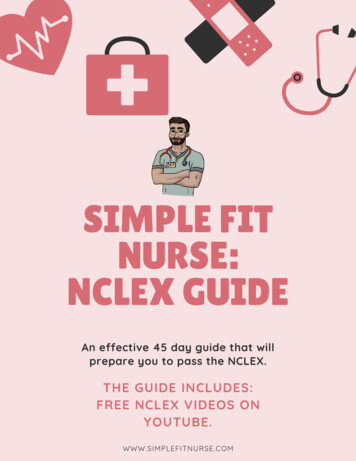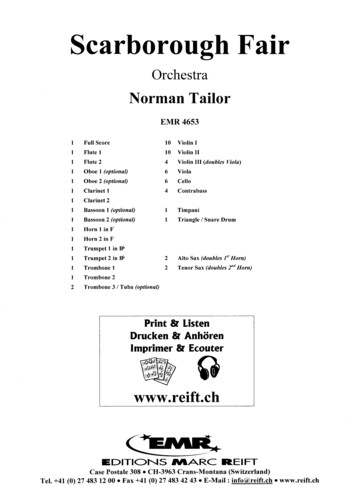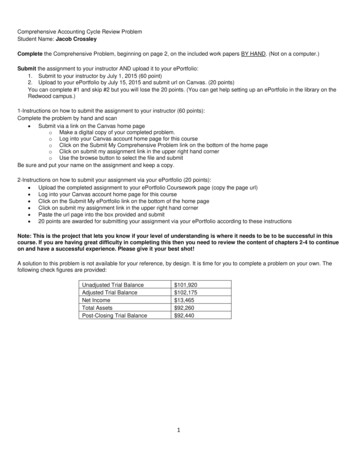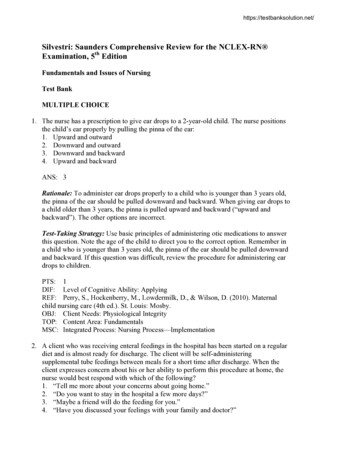
Transcription
https://testbanksolution.net/Silvestri: Saunders Comprehensive Review for the NCLEX-RN Examination, 5th EditionFundamentals and Issues of NursingTest BankMULTIPLE CHOICE1. The nurse has a prescription to give ear drops to a 2-year-old child. The nurse positionsthe child’s ear properly by pulling the pinna of the ear:1. Upward and outward2. Downward and outward3. Downward and backward4. Upward and backwardANS: 3Rationale: To administer ear drops properly to a child who is younger than 3 years old,the pinna of the ear should be pulled downward and backward. When giving ear drops toa child older than 3 years, the pinna is pulled upward and backward (“upward andbackward”). The other options are incorrect.Test-Taking Strategy: Use basic principles of administering otic medications to answerthis question. Note the age of the child to direct you to the correct option. Remember ina child who is younger than 3 years old, the pinna of the ear should be pulled downwardand backward. If this question was difficult, review the procedure for administering eardrops to children.PTS: 1DIF: Level of Cognitive Ability: ApplyingREF: Perry, S., Hockenberry, M., Lowdermilk, D., & Wilson, D. (2010). Maternalchild nursing care (4th ed.). St. Louis: Mosby.OBJ: Client Needs: Physiological IntegrityTOP: Content Area: FundamentalsMSC: Integrated Process: Nursing Process—Implementation2. A client who was receiving enteral feedings in the hospital has been started on a regulardiet and is almost ready for discharge. The client will be self-administeringsupplemental tube feedings between meals for a short time after discharge. When theclient expresses concern about his or her ability to perform this procedure at home, thenurse would best respond with which of the following?1. “Tell me more about your concerns about going home.”2. “Do you want to stay in the hospital a few more days?”3. “Maybe a friend will do the feeding for you.”4. “Have you discussed your feelings with your family and doctor?”
https://testbanksolution.net/2ANS: 1Rationale: A client often has fears about leaving the secure environment of a health carefacility. This client has a specific fear about not being able to handle tube feedings athome. An open communication statement such as “Tell me more about.” often leads tovaluable information about the client and his or her concerns. “Maybe a friend will dothe feeding for you.” and “Have you discussed your feelings with your family anddoctor?” are nontherapeutic responses because they place the client’s issues on hold.“Do you want to stay in the hospital a few more days?” is beyond the scope of practicefor the nurse to implement and may not be necessary.Test-Taking Strategy: Use therapeutic communication techniques to answer thequestion. “Tell me more about your concerns about going home.” focuses on the client’sfeelings. Remember to address the client’s feelings first. Review therapeuticcommunication techniques if you had difficulty with this question.PTS: 1DIF: Level of Cognitive Ability: ApplyingREF: Ignatavicius, D., & Workman, M. (2010). Medical-surgical nursing:patient-centered collaborative care (6th ed.). St. Louis: Saunders. Potter, P., & Perry, A.(2009). Fundamentals of nursing (7th ed.). St. Louis: Mosby.OBJ: Client Needs: Psychosocial IntegrityTOP: Content Area: FundamentalsMSC: Integrated Process: Communication and Documentation3. The nurse is administering enteral feedings via a nasogastric (NG) tube. The nurseshould do which of the following when caring for this client to maintain client safety?1. Keep the client in a supine position.2. Change the NG tube with every other feeding.3. Check for tube placement and residual amount at least every 4 hours.4. Increase the rate of the feeding if the infusion falls behind schedule.ANS: 3Rationale: NG tube feedings are beneficial but present possible complications such asdiarrhea, lactose intolerance, dumping syndrome, or excess fluid volume. The mostcommon complication is aspiration pneumonia caused by regurgitation of formulacontents from the stomach into the respiratory tract. This risk can be minimized bychecking the tube placement; the pH and color of aspirate and residual amount; and bykeeping the head of the bed elevated to 30 degrees at all times. Problems with diarrheamay be caused by infusing a formula that is cold, contaminated, or of the wrongconsistency or by infusing a formula too rapidly. Nasogastric tubes may be left in placefrom weeks to months, depending on the type of tube inserted. The feeding bag itselfshould be changed daily.Test-Taking Strategy: Use the process of elimination to assist in answering the question.Eliminate “change the NG tube with every other feeding” first because nasogastric tubes
https://testbanksolution.net/3may be left in place from weeks to months, depending on the type of tube inserted.Eliminate “keep the client in a supine position” next because a supine position couldcause aspiration pneumonia. Choose “check for tube placement and residual amount atleast every 4 hours” over “increase the rate of the feeding if the infusion falls behindschedule” because it is a definitive action that it helps protect the client from aspiration.Review the care of a client receiving NG tube feedings if you had difficulty with thisquestion.PTS: 1DIF: Level of Cognitive Ability: ApplyingREF: Potter, P., & Perry, A. (2009). Fundamentals of nursing (7th ed.). St. Louis:Mosby.OBJ: Client Needs: Physiological IntegrityTOP: Content Area: FundamentalsMSC: Integrated Process: Nursing Process—Implementation4. The client with pancreatitis is being weaned from parenteral nutrition (PN). The clientasks the nurse why the PN cannot just be stopped. The nurse includes in a response tothe client that which of the following complications could occur with sudden terminationof PN formula?1. Dehydration2. Hypokalemia3. Hypernatremia4. Rebound hypoglycemiaANS: 4Rationale: Clients receiving PN are receiving high concentrations of glucose. To givethe pancreas time to adjust to decreasing glucose loads, the infusion rates are tapereddown. Prior to discontinuing the PN, the body must adjust to the lowered glucose level.If the PN were suddenly withdrawn, the client could have rebound hypoglycemia.Although the other options are potential complications, they are not risks associated withdiscontinuing PN abruptly.Test-Taking Strategy: Use the process of elimination to answer the question. Recall thatPN solutions contain high concentrations of glucose; this will easily direct you to“rebound hypoglycemia.” Review the components of a PN solution and theconsiderations related to weaning if you had difficulty with this question.PTS: 1DIF: Level of Cognitive Ability: ApplyingREF: Gahart, B., & Nazareno, A. (2010). 2010 Intravenous medications: a handbookfor nurses and health professionals (26th ed.). St. Louis: Mosby. Ignatavicius, D., &Workman, M. (2010). Medical-surgical nursing: patient-centered collaborative care (6thed.). St. Louis: Saunders.OBJ: Client Needs: Physiological IntegrityTOP: Content Area: Fundamentals
https://testbanksolution.net/4MSC: Integrated Process: Nursing Process—Implementation5. The nurse hears in intershift report that a client receiving parenteral nutrition (PN) at 100mL/hr has bilateral crackles and 1 pedal edema. When the nurse obtains a daily weight,the nurse notes that the client has gained 4 lb in 2 days. Which of the following nursingactions should the nurse take first?1. Encourage the client to cough and deep-breathe.2. Compare the intake and output records of the last 2 days.3. Slow the PN infusion rate to 50 mL/hr per infusion pump.4. Administer the prescribed daily diuretic, and check the client in 2 hours.ANS: 2Rationale: The client is showing signs of fluid retention and possible excess fluid intake,as noted by the presence of crackles, edema, and weight gain. Noting the client’s intakeand output records adds to the database of information, which should then be reported.The problem may or may not be related to the PN. (Other possible causes are impairedrespiratory, cardiovascular, or renal function.)Test-Taking Strategy: Use the process of elimination, focusing on the client dataprovided in the question. Also note the strategic word “first.” Eliminate “slow the PNinfusion rate to 50 mL/hr per infusion pump” because the nurse should not decrease theinfusion rate without a physician’s prescription. Additionally, it is not recommended toincrease or decrease the rate of PN infusions because of the problems of hyperosmolardiuresis, hypoglycemia, or hyperglycemia. Eliminate “encourage the client to cough anddeep-breathe” because this action will have little if any effect on peripheral edema andweight gain. Eliminate “administer the prescribed daily diuretic, and check the client in2 hours” because this action may delay necessary and immediate treatment and isincorrect. Review the complications and associated nursing interventions of parenteralnutrition (PN) if you had difficulty with this question.PTS: 1DIF: Level of Cognitive Ability: ApplyingREF: Ignatavicius, D., & Workman, M. (2010). Medical-surgical nursing:patient-centered collaborative care (6th ed.). St. Louis: Saunders.OBJ: Client Needs: Physiological IntegrityTOP: Content Area: FundamentalsMSC: Integrated Process: Nursing Process—Implementation6. The nurse is caring for a client receiving parenteral nutrition (PN) via a central line. Thenurse should monitor which of the following to detect the development of the mostcommon complication of PN?1. Temperature2. Daily weight3. Intake and output (I&O)4. Serum blood urea nitrogen (BUN) level
https://testbanksolution.net/5ANS: 1Rationale: The most common complication associated with PN is infection. Monitoringthe temperature would provide data that would indicate infection in the client.Monitoring the serum BUN level would not provide information related to infection andis most closely related to assessing renal function. Weighing the client daily andmonitoring I&O would provide information related to fluid volume overload.Test-Taking Strategy: Use the process of elimination to assist in answering the question.Focus on the subject of the question, the most common complication of PN. Eliminate“daily weight” and “intake and output (I&O)” first because they are comparable or alike.Recall that infection is the most common complication to make your final selection.Review the complications associated with PN if you had difficulty with this question.PTS: 1DIF: Level of Cognitive Ability: AnalyzingREF: Ignatavicius, D., & Workman, M. (2010). Medical-surgical nursing:patient-centered collaborative care (6th ed.). St. Louis: Saunders.OBJ: Client Needs: Physiological IntegrityTOP: Content Area: FundamentalsMSC: Integrated Process: Nursing Process—Assessment7. The nurse is providing care to a client with continuous tube feedings through anasogastric (NG) tube. The nurse should avoid doing which of the following, which isnot part of the standard care for a client receiving enteral nutrition?1. Check the residual every 4 hours.2. Check for placement every 4 hours.3. Hang a new feeding bag every 72 hours.4. Check for placement prior to administering medications through the tube.ANS: 3Rationale: A feeding bag and tubing should be changed every 24 hours (or per agencyprotocol) to reduce risk of bacterial contamination. Placement and residual should bechecked at least every 4 hours during administration of continuous tube feedings andprior to giving medications through the tube.Test-Taking Strategy: Note the strategic words “avoid” and “not” in the question. Thesewords indicate a negative event query and the need to select the incorrect action.Visualize the procedure to assist in answering the question. Eliminate each of theincorrect options because they are comparable or alike. If you had difficulty with thisquestion, review the nursing care associated with continuous tube feedings.PTS:DIF:1Level of Cognitive Ability: Applying
https://testbanksolution.net/6REF: Ignatavicius, D., & Workman, M. (2010). Medical-surgical nursing:patient-centered collaborative care (6th ed.). St. Louis: Saunders. Potter, P., & Perry, A.(2009). Fundamentals of nursing (7th ed.). St. Louis: Mosby.OBJ: Client Needs: Physiological IntegrityTOP: Content Area: FundamentalsMSC: Integrated Process: Nursing Process—Implementation8. The nurse is monitoring the nutritional status of the client receiving enteral nutrition.The nurse monitors which of the following to determine the effectiveness of the tubefeedings for this client?1. Daily weight2. Calorie count3. Serum protein level4. Daily intake and outputANS: 1Rationale: The most accurate measurement of the effectiveness of nutritionalmanagement of the client is through the use of daily weighing. These should be doneevery day at the same time (preferably early morning), in the same clothes, and using thesame scale. “Calorie count,” “serum protein level,” and “daily intake and output” assistin measuring nutrition and hydration status. However, the effectiveness of the diet ismeasured by maintenance of body weight.Test-Taking Strategy: The strategic word in the question is “effectiveness.” This tellsyou that the correct option is an outcome rather than a tool to measure the outcome.With this in mind, eliminate “calorie count,” and “daily intake and output” first becausethese are tools that the nurse uses to measure nutritional and fluid status. Eliminate“serum protein level” next, because it reflects only one component of the diet, namely,protein. If you had difficulty with this question, review the methods of monitoring theeffectiveness of the tube feedings.PTS: 1DIF: Level of Cognitive Ability: EvaluatingREF: Ignatavicius, D., & Workman, M. (2010). Medical-surgical nursing:patient-centered collaborative care (6th ed.). St. Louis: Saunders.OBJ: Client Needs: Physiological IntegrityTOP: Content Area: FundamentalsMSC: Integrated Process: Nursing Process—Evaluation9. A client is scheduled for insertion of a peripherally inserted central catheter (PICC) andthe nurse explains the advantages of this catheter. The nurse determines that the clientneeds additional information about the catheter if the client makes which statement?1. “It is reasonable in cost.”2. “There is less pain and discomfort than other types of catheters.”3. “This type of catheter is very reliable.”4. “It is specifically designed for short-term use.”
https://testbanksolution.net/7ANS: 4Rationale: PICCs are intended to be used for clients who need long-term catheterplacement. They can be left in place for several months. It is reasonable in cost becausethe catheter does not need routine replacement, as do traditional peripheral IV catheters.The catheter is more comfortable for the client because there is no repeated venipuncturewith catheter change. The catheter is also very reliable. It is less likely to infiltrate andcan be used for administration of a number of different types of medications.Test-Taking Strategy: Note the strategic words “needs additional information.” Thesewords indicate a negative event query and tell you that the correct option will be anincorrect statement about this type of catheter. Use general nursing knowledge about thepurposes of this catheter to choose correctly. The strategic words “short-term” will assistin directing you to “It is specifically designed for short-term use.” Review thecharacteristics of a PICC if you had difficulty with this question.PTS: 1DIF: Level of Cognitive Ability: EvaluatingREF: Ignatavicius, D., & Workman, M. (2010). Medical-surgical nursing:patient-centered collaborative care (6th ed.). St. Louis: Saunders.OBJ: Client Needs: Physiological IntegrityTOP: Content Area: FundamentalsMSC: Integrated Process: Teaching and Learning10. A nurse is making initial rounds on the nursing unit to check the condition of assignedclients. The nurse notes that a client’s intravenous (IV) site is cool, pale, and swollen,and the solution is not infusing. The nurse interprets that which of the followingcomplications has been experienced by the client?1. Phlebitis2. Infection3. Infiltration4. ThrombosisANS: 3Rationale: An infiltrated IV is one that has dislodged from the vein and is lying insubcutaneous tissue. The pallor, coolness, and swelling are the result of IV fluid beingdeposited in the subcutaneous tissue. When the pressure in the tissues exceeds thepressure in the tubing, the flow of the IV solution will stop. The corrective action is toclamp the IV tubing, remove the catheter, and prepare to start a new IV line. The otherthree options are likely to be accompanied by warmth at the site, not coolness.Test-Taking Strategy: To answer this question accurately, you must be familiar with thesigns and symptoms that accompany various complications of IV therapy. Rememberthat pallor, coolness, and swelling are associated with infiltration. If this question wasdifficult, review the signs of infiltration.
https://testbanksolution.net/8PTS: 1DIF: Level of Cognitive Ability: UnderstandingREF: Ignatavicius, D., & Workman, M. (2010). Medical-surgical nursing:patient-centered collaborative care (6th ed.). St. Louis: Saunders.OBJ: Client Needs: Physiological IntegrityTOP: Content Area: FundamentalsMSC: Integrated Process: Nursing Process—Assessment11. The nurse has been assigned to the care of four adult clients who are receivingcontinuous intravenous (IV) infusions. The nurse planning the work assignment for theshift makes a notation to check the IV sites of these clients at which of the followingfrequencies?1. Every hour2. Every 2 hours3. Every 3 hours4. Every 4 hoursANS: 1Rationale: Safe nursing practice includes monitoring an IV infusion at least once perhour in an adult client. The IV may be checked even more frequently, depending onwhether medication also is being infused.Test-Taking Strategy: Focus on the subject, and note that the question addresses adultclients. Remember that IV infusions need to be checked hourly for an adult client. If thisquestion was difficult, review care to the client receiving IV fluids.PTS: 1DIF: Level of Cognitive Ability: ApplyingREF: Perry, A., & Potter, P. (2010). Clinical nursing skills and techniques (7th ed.). St.Louis: Mosby.OBJ: Client Needs: Physiological IntegrityTOP: Content Area: FundamentalsMSC: Integrated Process: Nursing Process—Planning12. The client had a 1000-mL bag of 5% dextrose in 0.9% sodium chloride hung at 15:00.The nurse, making rounds at 15:45, finds the client is complaining of a poundingheadache, is dyspneic with chills, is apprehensive, and has an increased pulse rate. Theintravenous (IV) bag has 400 mL remaining. The nurse should take which of thefollowing actions first?1. Shut off the infusion.2. Sit the client up in bed.3. Remove the angiocatheter and IV.4. Place the client in Trendelenburg’s position.ANS: 1
https://testbanksolution.net/9Rationale: The client’s symptoms are compatible with speed shock (fluid volumeoverload). This may be verified by noting that 600 mL has infused in the course of 45minutes. The first action of the nurse from the options presented is to shut off theinfusion. The nurse may elevate the head of bed to aid the client’s breathing. Placing theclient in Trendelenburg’s position is not an appropriate action and will increase thedyspnea. The nurse also notifies the physician. The angiocatheter does not need to beremoved. It may continue to be needed when the complication has been managed.Test-Taking Strategy: Note that the question contains the strategic word “first.” Focuson the data in the question, and note that the data indicate fluid volume overload. Thiswill direct you to “shut off the infusion.” Review nursing actions related to fluid volumeoverload for a client receiving intravenous fluids if you had difficulty with this question.PTS: 1DIF: Level of Cognitive Ability: ApplyingREF: Potter, P., & Perry, A. (2009). Fundamentals of nursing (7th ed.). St. Louis:Mosby.OBJ: Client Needs: Physiological IntegrityTOP: Content Area: FundamentalsMSC: Integrated Process: Nursing Process—Implementation13. The nurse notes that the site of a client’s peripheral intravenous (IV) catheter is reddened,warm, painful, and slightly edematous proximal to the insertion point of the IV catheter.After taking appropriate steps to care for the client, the nurse documents in the medicalrecord that the client has experienced:1. Phlebitis of the vein2. Infiltration of the IV line3. Hypersensitivity to the IV solution4. Allergic reaction to the IV catheter materialANS: 1Rationale: Phlebitis at an IV site can be distinguished by client discomfort at the site, aswell as by redness, warmth, and swelling proximal to the catheter. The IV line should bediscontinued, and a new line should be inserted at a different site. The remaining optionsare incorrect.Test-Taking Strategy: Remember that options that are comparable or alike are not likelyto be correct. In this case, “hypersensitivity to the IV solution” and “allergic reaction tothe IV catheter material” are comparable or alike and therefore are eliminated. Focus onthe data in the question to select “phlebitis of the vein” over “infiltration of the IV line.”Also recalling the signs of common IV complications will assist in answering correctly.Review the signs and symptoms of phlebitis if you had difficulty with this question.PTS:DIF:1Level of Cognitive Ability: Applying
https://testbanksolution.net/10REF: Ignatavicius, D., & Workman, M. (2010). Medical-surgical nursing:patient-centered collaborative care (6th ed.). St. Louis: Saunders.OBJ: Client Needs: Physiological IntegrityTOP: Content Area: FundamentalsMSC: Integrated Process: Nursing Process—Implementation14. The nurse has a written prescription to discontinue an intravenous (IV) line. The nurseobtains which of the following supplies from the unit supply area for use in applyingpressure to the site after removing the IV catheter?1. Band-Aid2. Alcohol swab3. Betadine swab4. Sterile 22 gauzeANS: 4Rationale: A dry sterile dressing, such as sterile 22 gauze, is used to apply pressureto the discontinued IV site. This material is absorbent, sterile, and nonirritating. ABetadine swab or alcohol swab would irritate the opened puncture site and would notstop the blood flow. A Band-Aid may be used to cover the site after hemostasis hasoccurred.Test-Taking Strategy: Visualize this procedure and think about each of the itemsidentified in the options to answer the question. The strategic words in the question are“applying pressure.” This will direct you to “sterile 22 gauze.” Review thisprocedure for removing an IV if you had difficulty with this question.PTS: 1DIF: Level of Cognitive Ability: ApplyingREF: Ignatavicius, D., & Workman, M. (2010). Medical-surgical nursing:patient-centered collaborative care (6th ed.). St. Louis: Saunders. Perry, A., & Potter, P.(2010). Clinical nursing skills and techniques (7th ed.). St. Louis: Mosby.OBJ: Client Needs: Physiological IntegrityTOP: Content Area: FundamentalsMSC: Integrated Process: Nursing Process—Implementation15. The nurse is preparing a continuous intravenous (IV) infusion at the medication cart. Asthe nurse prepares to attach the distal end of the IV tubing to a needleless device, thetubing drops and hits the top of the medication cart. Which of the following is theappropriate action by the nurse?1. Change the IV tubing.2. Attach a new needleless device.3. Wipe the tubing port with Betadine.4. Scrub the needleless device with an alcohol swab.ANS: 1
https://testbanksolution.net/11Rationale: The nurse should change the IV tubing because it has become contaminatedand could cause systemic infection to the client. Wiping the port with Betadine isinsufficient and would be contraindicated in any case, because the tubing will beattached directly to an angiocatheter in the client’s vein. The needleless device has notbeen contaminated and does not need replacement or cleansing.Test-Taking Strategy: Focus on the subject, contamination of the tubing. Note therelationship between the subject and “change the IV tubing.” Review aseptic techniqueif you had difficulty with this question.PTS: 1DIF: Level of Cognitive Ability: ApplyingREF: Potter, P., & Perry, A. (2009). Fundamentals of nursing (7th ed.). St. Louis:Mosby.OBJ: Client Needs: Safe and Effective Care EnvironmentTOP: Content Area: FundamentalsMSC: Integrated Process: Nursing Process—Implementation16. The nurse is collecting data from an African-American client scheduled for surgery.Which of the following questions would be of least priority for the nurse to ask on initialassessment?1. “Do you ever experience chest pain?”2. “Do you have any difficulty breathing?”3. “Do you have a close family relationship?”4. “Do you frequently have episodes of headache?”ANS: 3Rationale: In the African-American culture, it is considered to be intrusive to askpersonal questions on the initial contact or meeting. African Americans are highly verbaland express feelings openly to family or friends, but what transpires within the family isviewed as private. Psycho-social data are the least priority during the initial datacollection. Additionally, cardiovascular, neurological, and respiratory data includephysiological assessments that would be the priority.Test-Taking Strategy: Note the strategic words “least priority.” Use Maslow’sHierarchy of Needs theory to answer the question. “Do you ever experience chest pain?”“Do you have any difficulty breathing?” and “Do you frequently have episodes ofheadache?” address physiological needs. “Do you have a close family relationship?”addresses psychosocial needs. Review the characteristics of this culture if you haddifficulty with this question.PTS: 1DIF: Level of Cognitive Ability: UnderstandingREF: Giger, J., & Davidhizar, R. (2008). Transcultural nursing: assessment andintervention (5th ed.). St. Louis: Mosby.OBJ: Client Needs: Psychosocial Integrity
https://testbanksolution.net/12TOP: Content Area: FundamentalsMSC: Integrated Process: Nursing Process—Assessment17. The nurse is providing discharge instructions to an Asian-American client regardingprescribed dietary modifications. During the teaching session, the client continuouslyturns away from the nurse. Which of the following nursing actions is most appropriate?1. Continue with the instructions verifying client understanding.2. Walk around to the client so that you continuously face the client.3. Identify the importance of the instructions for the maintenance of health care.4. Give the client a dietary booklet, and return later to continue with the instructions.ANS: 1Rationale: Most Asian-American individuals maintain a formal distance with each other,which is a form of respect. Many are uncomfortable with face-to-face communications,especially when there is direct eye contact. If the client turns away from the nurse duringa conversation, the best action is to continue with the conversation. Walking around tothe client so that the nurse faces the client is in direct conflict with cultural practices.Identifying the importance of the instructions for the maintenance of health care may beviewed as degrading. Returning later to continue with the explanation may be viewed asa rude gesture.Test-Taking Strategy: Understanding the characteristics of this cultural group will assistin answering the question. Eliminate “identify the importance of the instructions for themaintenance of health care” and “give the client a dietary booklet, and return later tocontinue with the instructions” first, because these are nontherapeutic actions. From theremaining two options, “continue with the instructions verifying client understanding” isthe most therapeutic. If you had difficulty with this question, review the communicationpractices of this cultural group.PTS: 1DIF: Level of Cognitive Ability: ApplyingREF: Giger, J., & Davidhizar, R. (2008). Transcultural nursing: assessment andintervention (5th ed.). St. Louis: Mosby.OBJ: Client Needs: Psychosocial IntegrityTOP: Content Area: FundamentalsMSC: Integrated Process: Nursing Process—Implementation18. The nurse is planning to instruct the Hispanic-American client about nutrition anddietary restrictions. When developing the plan for the instructions, the nurse is awarethat this ethnic group:1. Primarily eats raw fish2. Enjoys eating red meat3. Views food as a primary form of socialization4. Eats bland food and food that lacks color, flavor, and textureANS: 3
https://testbanksolution.net/13Rationale: Hispanic-American foods are rich in color, flavor, texture, and spiciness. Inthe Hispanic-American culture, any occasion is seen as a time to celebrate with food andto enjoy the companionship of family and friends. Because food is a primary form ofsocialization in the Hispanic-American culture, they may have difficulty adhering to aprescribed diet. Asian Americans eat raw fish, rice, and soy sauce. European Americansprefer carbohydrates and red meat.Test-Taking Strategy: Knowledge regarding the food practices and preferences and themeaning of food in the Hispanic-American culture is required to answer this question.Remember that food is viewed as a primary form of socialization in theHispanic-American culture. If you had difficulty with this question, review the foodpreferences associated with this culture.PTS: 1DIF: Level of Cognitive Ability: UnderstandingREF: Giger, J., & Davidhizar, R. (2008). Transcultural nursing: assessment andintervention (5th ed.). St. Louis: Mosby.OBJ: Client Needs: Psychosocial IntegrityTOP: Content Area: FundamentalsMSC: Integrated Process: Nursing Process—Planning19. The nurse is preparing to assist a Jewish-American client with eating lunch. A koshermeal is delivered to the client. Which of the following nursing actions is mostappropriate in assisting the client with the meal?1. Unwrap the eating utensils for the client.2.
Silvestri: Saunders Comprehensive Review for the NCLEX-RN Examination, 5th Edition Fundamentals and Issues of Nursing Test Bank MULTIPLE CHOICE 1. The nurse has a prescription to give ear drops to a 2-year-old child. The nurse positions the child’s ear properly by pulling the pinna of
